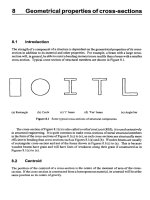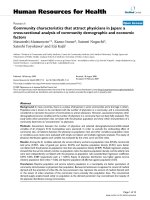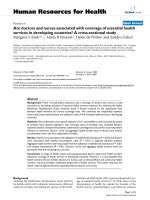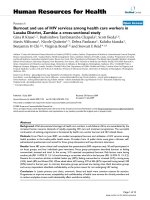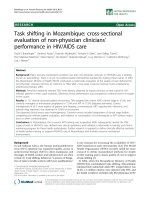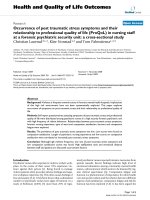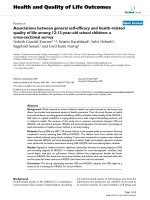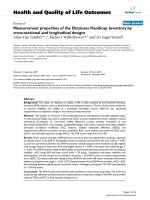GEOMETRIC PROPERTIES OF CROSS SECTION
Bạn đang xem bản rút gọn của tài liệu. Xem và tải ngay bản đầy đủ của tài liệu tại đây (226.91 KB, 12 trang )
8
Geometrical properties
of
cross-sections
8.1
Introduction
The strength of a component of a structure is dependent on the geometrical properties
of
its cross-
section in addition to its material and other properties. For example, a beam with a large cross-
section will, in general, be able to resist a bending moment more readily than a beam with a smaller
cross-section. Typical cross-section
of
structural members are shown in Figure 8.1.
(a) Rectangle
@)
Circle (c)
‘I’
beam
(d)
‘Tee’ beam (e) Angie
bar
Figure
8.1
Some typical cross-sections
of
structural components.
The
cross-section of Figure 8.l(c) is also called a
rolled steeljoist
(RSJ);
it is used extensively
in structural engineering. It is quite common to make cross-sections of metai structural members
inthe formofthe cross-sections ofFigure 8.l(c) to (e), as suchcross-sectionsare structurallymore
efficient
in
bending than cross-sections such as Figures 8.l(a) and (b). Wooden beams are usually
of rectangular cross-section and not of the forms shown in Figures 8.l(c) to (e). This is because
wooden beams have grain and will have lines of weakness along their grain if constructed as in
Figures 8.l(c) to (e).
8.2
Centroid
The position of the centroid
of
a cross-section is the centre of the moment of area
of
the cross-
section. If the cross-section is constructed from a homogeneous material, its centroid will lie at the
same position as its centre of gravity.
Centroidal axes
20
1
Figure
8.2
Cross-section.
Let
G
denote the position of the centroid of the plane lamina of Figure
8.2.
At the centroid the
moment
of
area
is
zero,
so
that the following equations apply
Zx
dA =ZydA
=
0
(8.1)
where
dA
=
elemental area of the lamina
x
=
horizontal distance of
dA
from
G
y
=
vertical distance
of dA
from
G
8.3
Centroidal
axes
These are the axes that pass through the centroid.
8.4
Second moment
of
area
(I)
The second moments
of
area of the !amina about the
x
-
x
and
y
-
y
axes, respectively, are given
by
1,
=
C
y2
dA
=
second moment of area about
x
-
x
Zw
=
C
x2
dA
=
second moment of area about
y
-
y
(8.2)
(8.3)
Now from Pythagoras’ theorem
x2+y2
=
?
:.
Ex’
d~
+
Cy2
d~
=
Cr2
d~
or
Zp+Zn
=
J
(8.4)
202
Geometrical properties
of
cross-sections
Figure
8.3
Cross-section.
where
J
=
polar second moment of area
=Cr2
d~
(8.5)
Equation
(8.4)
is
known
as theperpendicular axes theorem which states that the sum of the second
moments of area
of
two
mutually perpendicular axes of a lamina is equal to the polar second
moment of area about a point where these
two
axes cross.
8.5
Parallel
axes
theorem
Consider the lamina of Figure
8.4,
where the
x-x
axis passes through its centroid. Suppose that
I,
is known and that
I,
is required, where the
X-X
axis lies parallel to the
x-x
axis and at a
perpendicular distance
h
from it.
Figure
8.4
Parallel axes.
Paraliel
axes
theorem
203
Now from equation
(8.2)
I,
=
Cy’
dA
and
In
=
C(y+
h)’
dA
=
E
(‘y’
+
h2
+
2
hy)
dA,
but
C
2
hy
dA
=
0,
as
‘y
’
is measured from the centroid.
but
I,
=
Cy’
dA
:.
In
=
I,
+
h’
C
dA
=
I,
+
h’
A
where
A
=
areaoflamina
=
CdA
Equation
(8.9)
is
known
as theparallel
axes
theorem, whch states that the second moment of area
about the
X-X
axis is equal to the second moment
of
area about the
x-x
axis
+
h’
x
A,
where
x-x
and
X-X
are parallel.
h
=
the perpendicular distance between the
x-x
and
X-X
axes.
I,
=
the second moment of area about
x-x
In
=
the second moment
of
area about
X-X
The importance
of
the parallel axes theorem
is
that it
is
useful for calculating second moments of
area of sections
of
RSJs,
tees, angle bars etc. The geometrical properties of several cross-sections
will now be determined.
Problem
8.1
Determine the second moment of area of the rectangular section about
its
centroid
(x-x)
axis and its base
(X-X
)
axis; see Figure
8.5.
Hence or
otherwise, verify the parallel axes theorem.
204
Geometrical properties
of
cross-sections
Figure 8.5
Rectangular section.
Solution
From
equation
(8.2)
I*,
=
[y2
dA
=
[-;
Y2
(B
dy)
(8.10)
=
-b3y
2B
=
B[$E/2
3
Zxx
=
BD3/12 (about
centroid)
Zm
=
ID''
(y
+
DI2)' B
dy
-D/2
=
B
ID/2
(y'
+
D2/4
+
Dy)
4
-DR
(8.11)
3
DZy
@,2
I'
=
B
[:
+.
-
4
+
TrDI2
Ixy
=
BD313 (about base)
To
verify
the
parallel axes theorem,
Parallel axes theorem
2G5
from equation
(8.9)
I,
=
Ixx
+
h2
x
A
2
=
-+(:)
BD
3
xBD
12
=
BD3
112
(1
+
:)
I,
=
BD3/3
QED
Problem
8.2
Detennine the second moment
of
area about
x-x,
of
the circular cross-section
of Figure 8.6. Using the perpendicular axes theorem, determine the polar
second moment
of area, namely
‘J’.
Figure
8.6
Circular
section.
Solution
From the theory
of
a circle,
2i-y’
=
R2
or
9
=
R2-2
(8.12)
Let
x
=
Rcoscp (seeFigure
8.6)
:.
y’
=
R2
-
R2
cos2
cp
(8.13)
=
R2sin2cp
(8.14)
206
Geometrical properties
of
cross-sections
or
y
=
Rsincp
and
dy
-
Rcoscp
4
or
dy
=
Rcoscp
dcp
Now
A
=
area
of
circle
R
=
4lxdy
0
=
4
R
coscp Rcoscp
dcp
0
HI2
7
=
4R2
]cos2
cp
dcp
0
1
+
cos24
but cos2cp
=
2
z
12
=
2R2
[(:+
0)
-
(o+ o)]
or
A
=
xR2
QED
NOW
I,
=
4
y
x
dy
Substituting equations
(8.14), (8.13)
and
(8.16)
into equation
(8.18),
we get
R12
0
XI2
I,
=
4 R2
sin2cp
Rcoscp Rcoscp
dcp
0
n12
I
=
4R4
I
sin2cp
cos2cp
dcp
0
but
sin2
=
(1
-
COS
2
9)/2
(8.15)
(8.16)
(8.17)
(8.18)
Parallel
axes
theorem
207
and cos’cp
=
(1
+
cos 2cp)12
XI2
0
:.
I,
=
R4
I
(1
-
COS
2~)
(1
+
COS
2cp)
d
cp
XI2
0
=
R4
(1
-
cos’2~)
d
cp
1
+
cos
441
2
but cos’2cp
=
1
dT
-
R4=r
[
1-
1+cos4$
1,
-
2
0
sin
49
4
-
912-
-
=
P[(x12-
XI4
-
0)
-
(0-0-O)]
or
Ixx
=
xR414
=
xD4164
where
D
=
diameter
=
2R
As
the circle is symmetrical about
x-x
and
y-y
IH
=
Ixx
=
nD4164
From the perpendicular axes theorem
of
equation
(8.4),
J
=
polar second moment
of
area
=
I,
+
I,
=
xD4/64+x D4164
(8.19)
(8.20)
or
J
=
xD4132
=
xR412
208
Geometrical properties
of
cross-sections
Problem
8.3
Determine the second moment of area about
its
centroid of the
RSJ
of
Figure
8.7.
Figure
8.7
RSJ.
Solution
I,
=
‘I’
of outer rectangle
(abcd)
about
x-x
minus
the
sum
of
the
1’s
of the
two
inner
rectangles (efgh and
jklm)
about
x-x.
0.11
x
0.23
2
x
0.05
x
0.173
- -
-
12 12
=
7.333
x
10.~
-
4.094
x
io-5
or
I,
=
3.739
x
10-’m4
Problem
8.4
Determine
I
for the cross-section of the
RSJ
as
shown
in
Figure
8.8.
Figure
8.8
RSJ
(dimensions in metres).
Parallel
axes
theorem
209
Col.
3
Col.
4
Col.
5
Y
aY
au’
0.1775 2.929
x
10
‘
5.199
x
0.095 1.425
x
1.354
x
10
0.01
4.2
x
10.’ 4.2
10
’
-
Z
ay
=
4.77
x
Z
ay
=
6.595
x
10
‘
10.~
Solution
Col.
6
i
=
bbl,,
0.11
X
0.0153/12
=
3
x
10
0.01
X
0.153/12
=
2.812
x
0.21
x
0.02~/12
=
1.4
x
10.’
T3
i
=
2.982
x
The calculation will be carried out with the aid
of
Table
8.1.
It should be emphasised that this
method
is
suitable
for
almost
any
computer spreadsheet.
To
aid
this
calculation, the
RSJ
will be
subdwided into three rectangular elements, as shown in Figure
8.8.
Col.
1
Element
Col.
2
a
=
bd
0.11
x
0.015
=
0.00165
0.01
x
0.15
=
0.0015
0.02
x
0.21
=
0.0042
Za=
0.00735
u
=
area
of
an
element (column
2)
y
=
vertical distance
of
the local centroid of an element
from
XX
(column
3)
uy
=
the product
a
x
y
(column
4
=
column
2
x
column
3)
u9
=
the product
a
x
y
x
y
(column
5
=
column
3
x
column
4)
i
b
=
‘width’ of element (horizontal dimension)
d
C
=
summationofthecolumn
y
=
the second moment
of
area
of
an element about its own local centroid
=
bd3i12
=
‘depth’ of element (vertical dimension)
-
=
distance
of
centroid
of
the cross-section about
XX
=
ZuyiZa
=
4.774
x
10-4/0.00735
=
0.065
m
(8.21)
(8.22)
210
Geometrical properties
of
cross-sections
Now from equation (8.9)
I,
=
Cay’
+Xi
=
6.595
x
lO-5
+
2.982
x
1O-6
(8.23)
I,
=
6.893
x
lO-5
m4
From the parallel axes theorem (8.9),
-
I,,
=
I,
-y’Ca
=
6.893
x
lO-5
-
0.065’
x
0.00735
(8.24)
or
Ixx
=
3.788
x
lO-5
m4
Further
problems
(for
answers, seepage
692)
8.5
Determine
I,
for
the thin-walled sections shown
in
Figures 8.9(a) to 8.9(c), where the
wall thicknesses are
0.01
m.
Dimensions are in metres.
I,
=
second moment
of
area about a horizontal axis passing
through the centroid.
NB
(4
(b)
(c)
Figure
8.9
Thin-walled sections.
Further problems
21
1
8.6
Determine
I,
for the thm-walled sections shown in Figure 8.10, which have wall
thicknesses of 0.01 m.
(a)
(b)
Figure 8.10
8.7
Determine the position of the centroid of the section shown
in
Figure 8.1 1, namely
y.
Determine also
I,
for this section.
Figure 8.11
Isosceles
triangular
section.

